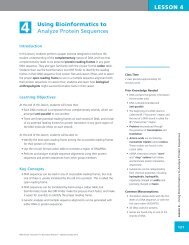WET LAB DNA Barcoding: From Samples to Sequences - Northwest ...
WET LAB DNA Barcoding: From Samples to Sequences - Northwest ...
WET LAB DNA Barcoding: From Samples to Sequences - Northwest ...
Create successful ePaper yourself
Turn your PDF publications into a flip-book with our unique Google optimized e-Paper software.
<strong>WET</strong> <strong>LAB</strong><br />
Wet Lab: Slide #21<br />
[Note: <strong>DNA</strong> sequencing is more sensitive<br />
at detecting <strong>DNA</strong> than many of the<br />
<strong>DNA</strong> gel staining techniques used in<br />
classrooms. Therefore, students who do<br />
not see a <strong>DNA</strong> band on their agarose gel<br />
in Lab 3 are still encouraged <strong>to</strong> proceed<br />
with Lab 4 and submit their purified <strong>DNA</strong><br />
sample for <strong>DNA</strong> sequencing.]<br />
36. Show Slide #22, and remind students that their overall goal is <strong>to</strong> obtain<br />
<strong>DNA</strong> sequence data from the species they are studying. In the last experiment,<br />
students analyzed their PCR products using agarose gel electrophoresis. Today,<br />
they will prepare their PCR samples for <strong>DNA</strong> sequencing.<br />
Wet Lab: Slide #22<br />
Using Bioinformatics: Genetic Research<br />
37. Show one of the <strong>DNA</strong> sequencing tu<strong>to</strong>rials <strong>to</strong> familiarize students with the<br />
process of <strong>DNA</strong> sequencing, listed above under Lab 4: Teacher Preparation.<br />
38. Show Slide #23, and review with students the components and logic of<br />
<strong>DNA</strong> sequencing. <strong>DNA</strong> sequencing is an adaptation of PCR, and has many of<br />
the same components:<br />
a. <strong>DNA</strong> Template: The student’s PCR product.<br />
b. Taq <strong>DNA</strong> polymerase: This is a special <strong>DNA</strong> polymerase that is used <strong>to</strong><br />
copy the <strong>DNA</strong> and is heat stable, so that the enzyme is not destroyed by the<br />
high temperatures during the PCR.<br />
c. Primers: These are small pieces of <strong>DNA</strong> that are specific <strong>to</strong> the sample<br />
being sequenced. They bind <strong>to</strong> the 5’ and 3’ regions of the gene <strong>to</strong> be<br />
copied, instructing the Taq <strong>DNA</strong> polymerase where <strong>to</strong> start <strong>DNA</strong> replication.<br />
d. Buffer and water: As this is a biological reaction, we must add buffers that<br />
mimic the inside of the cell for the Taq <strong>DNA</strong> polymerase <strong>to</strong> function properly.<br />
342<br />
©<strong>Northwest</strong> Association for Biomedical Research—Updated Oc<strong>to</strong>ber 2012
















